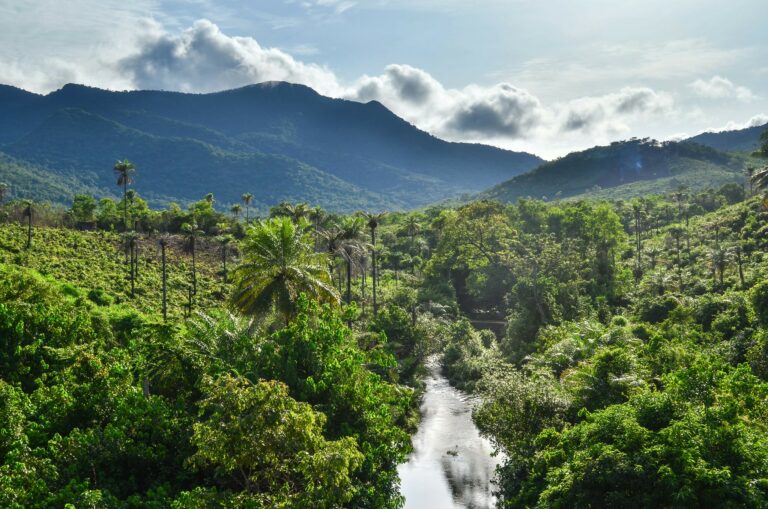Realising the promise of forest carbon credits: embedding rigorous learning into REDD+ programme design

Can carbon offset projects intended to protect tropical forests deliver on their promised benefits? Our impact evaluation of a REDD+ project in Sierra Leone provides new evidence, writes Elisabeth Gsottbauer.
Recent controversies have brought a welcome boost to the scrutiny of voluntary carbon offset projects intended to protect forests in exchange for sellable carbon credits. The evidence base is growing, with studies questioning if these REDD+ projects – ‘Reducing Emissions from Deforestation and Degradation’ – truly reduce deforestation as claimed. Colleagues and I recently conducted an independent and rigorous impact evaluation of a certified REDD+ project in Sierra Leone’s Gola Rainforest to assess its environmental and socioeconomic impacts five years after implementation.
Deforestation is a dire issue in Sierra Leone, with the country having lost 25% of its forests in 20 years. Pressure on remaining forests in protected areas is also intense. It is in this context that we evaluated whether REDD+ projects can reduce deforestation rates, by examining deforestation dynamics in the Gola Project which operates in the buffer zone of an important protected area, the Gola Rainforest National Park. The project received carbon credit certification in 2015 and aims to slow down the rate of deforestation while not undermining household livelihoods.
Delivering on promises – to a degree
We collected multiple rounds of household surveys and satellite data covering the 126 communities receiving project interventions. REDD+ projects are often comprised of multiple interventions implemented in bundles and may include savings and loans, payments or agricultural training. We compared these communities that received interventions with 202 communities that did not but were otherwise comparable in terms of their size, location or accessibility.
The results indicate that REDD+ does appear to be delivering on its promises to some degree. It has reduced deforestation by 30% in targeted communities, which equates to avoiding the loss of 929 hectares of forest on a yearly basis. Through this mechanism, the project also led to 340,000 tons of avoided CO2 emissions per year, at an abatement cost of $1.12 per ton. This suggests not only that the project is delivering but that it is also relatively cost-effective in creating carbon savings.
Despite these promising findings on the effectiveness of the REDD+ programme design, we found no clear evidence that the project improved local economic wellbeing over its first five years. However, encouragingly, nor did the project negatively impact local incomes, consumption patterns or assets held. Our results suggest that more could be done if improving the material aspects of local livelihoods were desired as a core part of project objectives.
What exactly could be driving the reduction in deforestation?
We went further to explore a series of potential mechanisms that might be driving the reduced deforestation rates. For instance, perhaps the project results were achieved through changing conservation attitudes or by impacting labour markets. We found evidence only for the latter: REDD+ communities have both reduced labour available for farming and increased wages. Why? The findings suggest that the project’s interventions increased the opportunity cost of labour, thereby diverting it away from forest clearing activities and thus reducing deforestation rates. We also found some suggestive evidence that project participants developed an increased reliance on income sources that are decoupled from deforestation, like non-timber forest products and cocoa – aligning with the project’s push towards forest-friendly livelihoods alternatives.
Multi-stakeholder collaboration is needed to further expand the evidence base
Overall, our independent causal impact evaluation offers robust evidence that well-designed and implemented voluntary forest carbon projects can achieve meaningful environment benefits without hampering local economic incomes. More work is needed to understand the ways in which these projects impact the non-material elements of people’s lives, such as social relations, cultural practices or sense of place. However, our results suggest that reversing deforestation trends completely will require more than what is currently being delivered, and continued transparent validation to ensure appropriate livelihood supports are also effective and safeguard local communities.
As voluntary carbon markets boom, ensuring that credible evidence underpins offset credits will require impact assessment processes that are both transparent and cost-effective to scale up. Single evaluations like ours have value and offer a methodological way forward but their scope cannot match market growth. Such an effort will need expanded collaboration between project developers, financiers, communities and academia to embed impact evaluations into programme design from the outset. While particulars may differ across projects, the methodological approach and principles we utilise here can inform assessments of REDD+ initiatives globally. Generating an expanded evidence base through collaborative evaluation is essential for establishing the true potential of voluntary offset programmes to mitigate climate change ethically and effectively. We invite all stakeholders to join this urgent endeavour.
This commentary is based on a research article by Mandy Malan, Rachel Carmenta, Elisabeth Gsottbauer, Paul Hofman, Andreas Kontoleon, Tom Swinfield and Maarten Voors. Elisabeth Gsottbauer thanks her co-authors for their comments on an earlier draft of the commentary.
Read the full article: Malan M, Carmenta R, Gsottbauer E et al. Evaluating the impacts of a large-scale voluntary REDD+ project in Sierra Leone. Nature Sustainability 7: 120–129 (2024). https://doi.org/10.1038/s41893-023-01256-9

